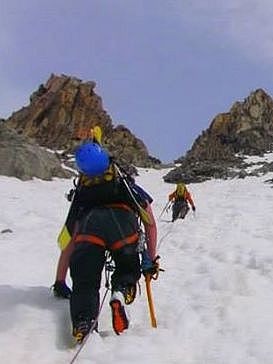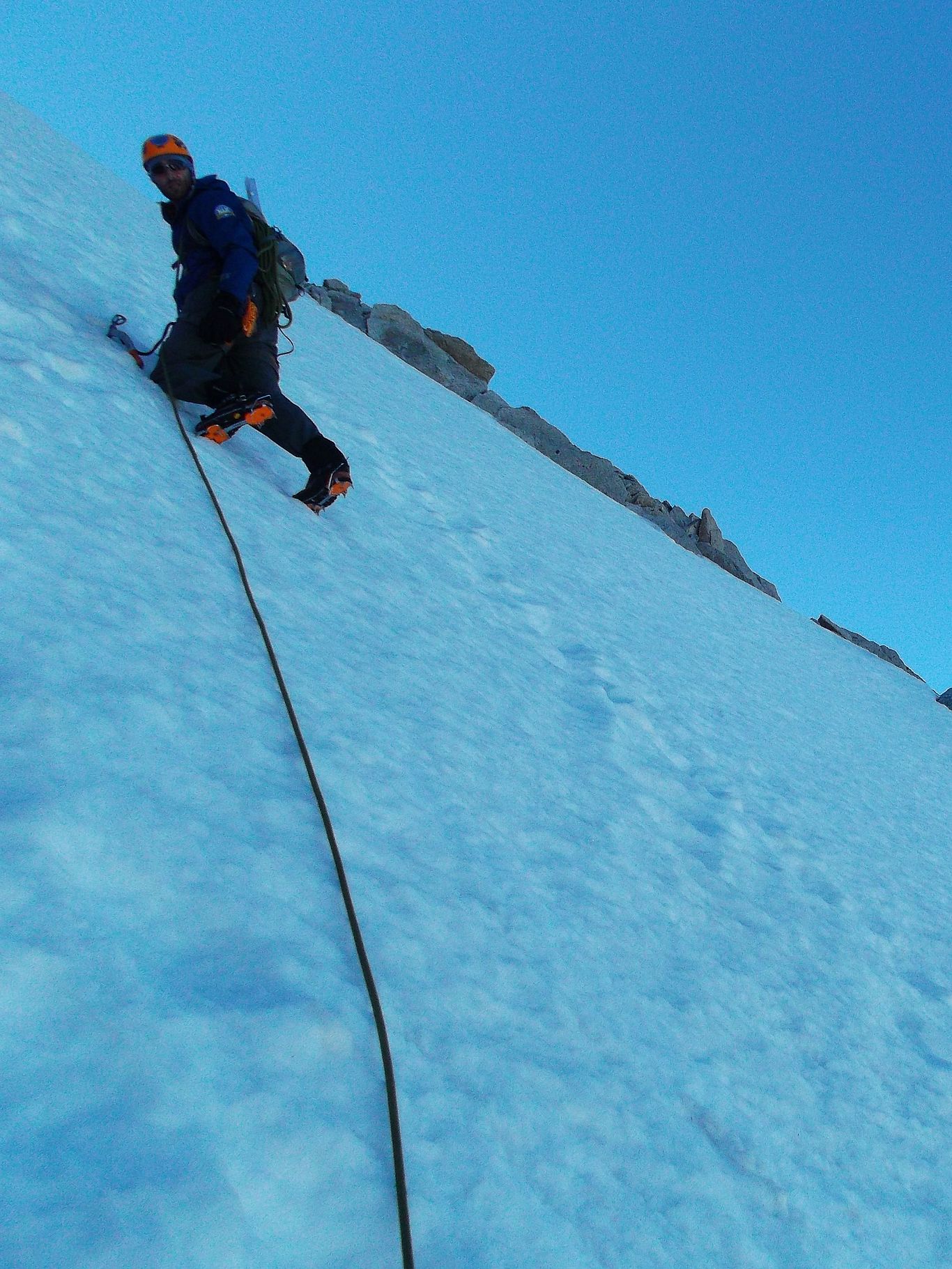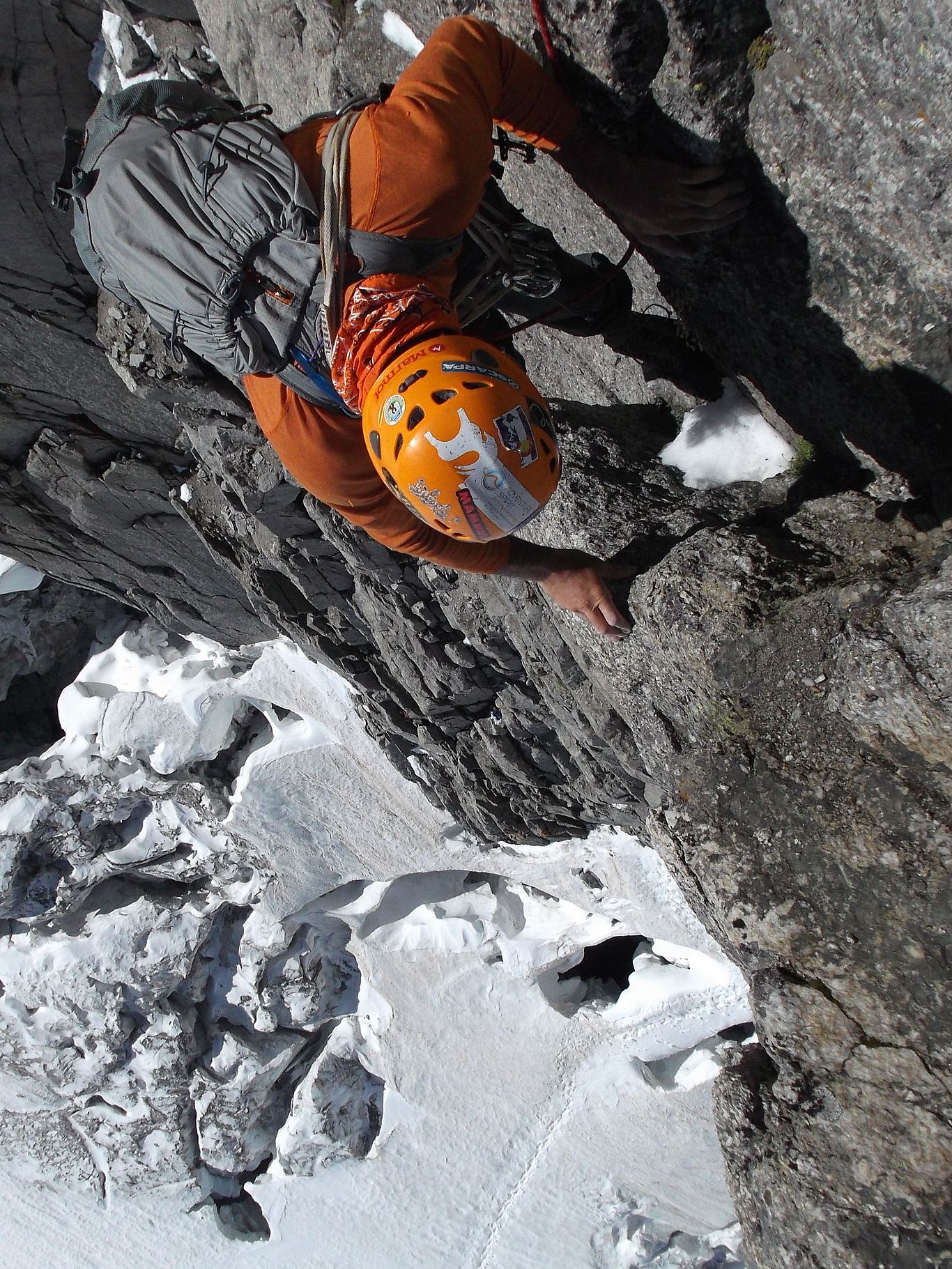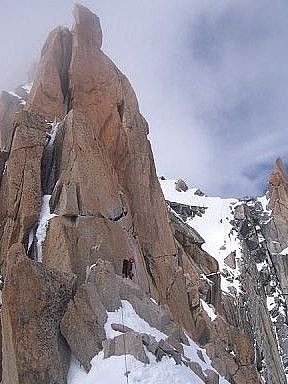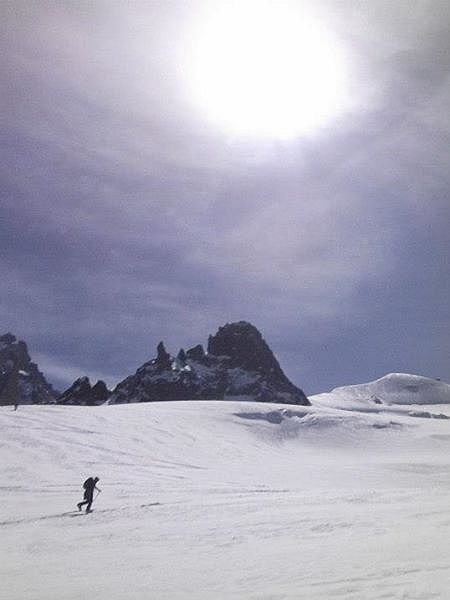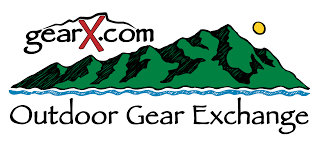
European Alpine Climbing Adventures
Clothing+Equipment List
General Notes
What really distinguishes the climbing in the French Alps is the broad range of terrain and experiences possible on any given day. If the weather is unsettled or we're looking for a shorter day, a quick ride up from the valley to the top of the Brevent lift delivers you to rock climbing options at 8,000' and no glacial travel necessary. Or a bluebird day might see us l crossing glacial expanses, then swinging tools into steep snow on Forbes Arete, then following the sinuous rock ridge to the 12,546' summit of Chardonnet. With this kind of variety, comes a need for some diversity in clothing and equipment. The list below provides a basic look at what you'll need. If you have specific questions regarding your climbing plans and objectives, we're always ready to help you in the climbing process.
The mountain town of Chamonix is reknowned as "The Birthplace of Alpinism." As such, there is probably no other place on Earth with as high a concentration of outdoor stores, so rental and purchase options are readily available. That said, overall the prices are higher than in the US and you may have trouble finding specific US items/brands that you enjoy.
For US-based purchases, we strongly recommend you check out Outdoor Gear Exchange. This independent outdoor retailer, based out of Burlington VT, has knowledgeable staff, a wide selection of quality gear, and very competitive pricing. And if you visit the Burlington bricks-and-mortar store, they've got great consignment deals (and don't forget to bring your own to consign).
We highly recommend Ortovox for all of your pack and clothing needs. Ortovox offers top-of-the-line quality, innovative style, and solid mountain performance, all produced with sharp attention to the environmental and labor stream.
As you go about putting your clothing and equipment together, let us know if you have any particular questions that your gear retailer can't answer.
Pack+Travel
1-2 Duffel Bags: For travel to Europe. 50-75 liters are good sizes. TSA approved travel locks can be useful—we've never had a problem in Europe, but this is a simple security step.
1 Backpack, 30L: One beautiful thing about Alps climbing is that our approaches are shortened by using "telecabines" (ski lifts, gondolas, etc). For day trips, a backpack in the 30L zone (plus or minus 5L) works well. One important thing to keep in mind is that, because we will be traveling in telecabines along with other people, we'll need to get all our "sharps" (crampons, screws, ideally even short axes) in our packs–so make sure your pack accomodates this. Simple packs specifically suited for alpine climbing (i.e., a pack without lots of external pockets and straps and with a relatively light waist-belt) work best. The Ortovox Peak 35L is a great option.
Electric Plug Converter: France uses "Type C or E" plugs.
Sim-Card: You may wish to purchase a sim-card while in France, so as to more cheaply make calls and use data on your phone. These are readily available. When you use a sim-card, your phone will have a new phone number. If you purchase a sim-card, be sure to email your guide to them know what your new number is.
Approach+Acclimatization
1-2 Trekking Poles: Collapsible (optional). There are many good models out there. We recommend a “flick lock” system versus a “twist-to-tighten” system, as those tend to freeze up and/or break easily.
Climbing Gear
1 Helmet: If you're bringing one of the lighter-weight polystyrene-type modern helmets, we strongly recommend that you either package it very well in your checked baggage or bring it with your carry-on, as they crack quite easily.
1 Harness: The specific style of harness will depend on our planned objectives. For more rock-oriented endeavors a harness in the style of the Mammut Togir Slide is effective. For ice-oriented endeavors a harness like to Togir, which has slots for holding ice screw racking carabiners is important (ask a sales rep to confirm your harness has this feature before purchasing). For more glacial alpine endeavors, a lightweight harness in the style of the Mammut Zephir Altitude is recommended, as they are lighter weight and easier to take on and off while keeping your boots and crampons on.
1-2 Ice Clippers: If we're planning ice climbing, these are very useful for racking ice screws. If you're looking to ice climb into the future and want to avoid lost gear and heartache, we highly recommend the beefy, metal DMM Vault-Gate, but Black Diamond Ice Clippers can work as well. Two is ideal.
2 Technical Ice Tools: Depending on our objectives, we need to be prepared to climb 40-90 degree snow and ice. The Petzl SumTec is a great option for this and future alpine climbs. If you think you'll be exploring a lot more vertical ice and want a tool that works well for both alpine ice and vertical ice, then consider something like the Petzl Quark or Nomic or the CAMP X-Alpine or X-Dream. For alpine climbing, it is best if one tool has an adze and one tool has a hammer.
1 Tool Tether: If our itinerary includes plans for steep snow or ice, remember that it's a looong way down from the summit and we don't want to drop our tools! While we don't want or need wrist leashes on our ice tools, tethers attaching them to our harness is a very good idea. We particularly like the BD Spinner Tether.
1 Crampon Pair: Horizontal front points work best for the alpine mix of steep snow and ice that we'll likely be climbing. We particularly enjoy the BD Snaggletooth, as it offers good kick penetration and mixed climbing versatility, but any 12-point crampon can work. Remember to be very sure to make sure that the crampons you're planning to bring to Europe fit the boots you're planning to bring–both in terms of the sizing and in terms of the boot binding/attachment system.
1 Belay Device: Any tubular-style “ATC” belay device works. If you're looking to progress with your multi-pitch climbing, spend the few extra dollars to get a “Guide” style “plaquette” belay device like the Petzl Reverso.
1 Petzl Microtraxion (optional): This device melds a pulley with a “progress-capturing” cleat, making it useful for crevasse rescue. (Like any tool, it's only useful if you've educated yourself about it.)
1 Petzl Tibloc (optional): The Tibloc is a stripped-down ascending device that can be useful for crevasse rescue. (Like any tool, it's only useful if you've educated yourself about it.)
2 Prussik Loops: Use 6mm cord, joined together in a 48cm loop using a double fishermans knot.
1 Double Length/240cm Sling, Nylon: Useful for rappeling. This BD Sling is a good option.
4 Locking Carabiners
4 Non-locking Carabiners: Used for racking gear on your harness—don't waste locking carabiners on this.
Hut Life
Most of our climbing will be accessed via lifts, such that we can leave from the valley after a morning espresso and be down in time see the sunset. But for some objectives overnight hut stays are necessary. In the event we've got some hut-based trips in mind, the below items are useful.
1 Sleeping Bag Liner: Huts typically provide bedding, but a sleeping bag liner is a nice addition. Rab makes some nice options.
Earplugs: People are leaving the hut at all hours of the night.
1 Headlamp: Good to have one high-beam option for your main lamp and one smaller one as a back-up. The Petzl Aktik Core is a good high-beam option. It is also smart to have a small back-up. The Petzl Bindi is a good back-up option.
1 Battery Charger (optional)
Kindle/Audiobooks/Podcasts/Etc (optional): Evenings at the hut typically allow for a bit of down time, so you may enjoy one of these options.
Food+Hydration
2 Liter Water Bottles: At least one should be wide-mouthed so it doesn't easily freeze and is easy to fill. Collapsible bottles allow for easier packing. We like the 2L MSR Dromedary—lightweight, collapsible, and very packable. You can bring a Camelback if you want for the approach hikes, but these often won't work for the summit climbing, as they freeze.
For any hut stays, we'll likely take our meals there.
France is all about food. There are beaucoup options for great sandwiches and baked goods down in the valley. These work great for most of your food, but be sure to have some quick-to-eat snack bars or other similar items as well.
Clothing+General Gear
Head
1 Warm Hat: Make sure it fits well under your helmet.
1 Sun Cap
1 Neck Gaiter: Buff or similar.
1 Headlamp: Rechargeable ones have come a long way and can be recharged via solar in camp. The Petzl Aktik Core is a good high-beam option.
2 Sunglass Pairs: Good to have one pair as a back-up. Must have some wrap-around protection and/or side filters.
1 Goggle: Only necessary for Mont Blanc and similar altitude climbs.
Spare Glasses/Contacts: As needed.
Hands
1 Thin Glove: Glove liner-weight. We strongly recommend a liner-weight glove that will easily fit under your heavier gloves. This allows you to remove your hand from the heavier glove and do more technical tasks while still having some protection from the elements.
1-2 Medium Glove: The OR Vitaly Glove is a good option. A second pair is nice as a next-day back-up if the first gets wet.
1 Thick Glove: The OR Alti Glove or lobster-claw mitten like the OR High Camp are good options.
Hand/Toe Warmers: For those early alpine starts, we sure love a bit of a boost. We use toe warmers both for the feet and the hands, as the adhesive, in combination with a thin glove liner can be used to stick the warmer to the top of the liner, so you don't lose it–we can show you how to do this.
Feet
1 Boot Pair: Your boot choice will vary according to several variables, including what month you'll be in the Alps, what altitude most of your objectives are at, how technical your objectives are, and how cold your feet tend to run. For warmer climbs, we like something like the La Sportiva Aequilibrium or Scarpa Ribelle. On colder climbs, we prefer something with an integral gaiter, like the La Sportiva G5. If you opt for a lighter weight boot, definitely plan to bring some toe-warmers as a buffer.
1 Trail Shoe Pair: Some climbs involve hut approaches. For these kinds of climbs, as well as for generally walking around lovely Chamonix, you may appreciate the comfort of a trail running-style shoe.
2-3 Sock Pairs: Wool is great for keeping odor low. We recommend Vermont's Darn Tough socks—with a lifetime warranty. No cotton! Two heavier-weight pairs and a medium-weight pair is optimal.
Liner socks (optional): These can be good if you're using toe-warmers. Put the toe-warmers on the top of the liner, then roll your other sock over it.
1 Gaiter Pair (Optional): Depending on the boot you use and the pants you wear, gaiters could be a good idea. Gaiters help prevent snow/dirt getting in your boot and prevent tripping on and ripping your pants. If you boot has an integral gaiter, like the La Sportiva G5, you don't need gaiters. Or if you have pants with low-profile, tight ankle cuffs, you may not choose to use gaiters either.
Upper/Lower Body
We think of layering as a “3W” system: Wicking (base), Warmth (insulation), and Weather (shell) layers. There are lots of layering options out there—fleece, wool, down, and synthetic fill—so there are a variety of ways to accomplish the task. Generally, our days begin in the warm valley, but within a few minutes we emerge up in the cool alpine, thanks to the infrastructure of lifts. And while the skies generally range from clear to partly cloudy, rain and snow are definitely possible.
Laundromats and laundry services are available in Chamonix.
Lower Body
2-3 Pair Boxer/Briefs/Underwear: Wool or synthetic for climbing days, no cotton.
1 Pair Long Mid-Weight Underwear: Wool or synthetic. Here are some good sample options.
1 Pair Mid-Weight Soft-shell Pant: For climbing.
1 Pair Light-Weight Soft-shell/Trekking Pant: For acclimatization/approach hikes and base camp.
1 Pair Hard-Shell Pant: Must have ¾ or more side zip, so that you can put them on with crampons on and access the belay loop of your harness. Be absolutely sure to test this prior to arriving in Peru.
1 Pair Insulated Pants (optional): If you run really cold, these could be useful for summit day. Full or ¾ side zip is necessary.
Upper Body
1-2 Long Underwear Tops: Light or midweight. Wool or synthetic. Here are some good sample options.
1-2 Light-Weight Insulation Layers: Wool or synthetic fleece. Here are some good sample options.
1 Mid-Weight Insulation Layer: Down, synthetic, or wool fill. Hood recommended. The Ortovox Zebru is one of our favorites, to give you an idea of what to be looking for.
1 Sun Hoody (recommended): A full-sleeve, loose-fitting hoody can provide welcome relief from the sun.
1 Soft Shell: Should be wind-proof and water-resistant. Hood recommended.
1 Hard Shell: Should be wind-proof and very water-resistant. Hood necessary. The Ortovox Ortler Jacket is one of our favorites.
Heavy-Weight Down Parka: This is a must, providing a warmth during rest stops, an extra layer on bitter summit days, and a margin of safety in the event of emergencies. This parka should fit well over your upper body layers and under your harness. It must have a hood. We strongly recommend a high quality down fill (750 fill rating or higher) as sythetic fill is just too bulky.
Travel&Town Clothing
Bring the travel and town clothing you need in order to be comfortable during the town portion of this trip and for any other parts of your European travel.
Personal Effects
Passport: A must have! No visa necessary. Must be valid for 6 months after your date of travel. Make two copies, bring one with you, and leave another at home. Keeping one copy “on the cloud” is also advisable.
Personal Spending Money: While most places take credit cards, having some cash on hand is advisable. ATMs are readily available/
Toiletry Kit: With all the standard items you use, plus daily medications and back-up prescription copies.
Sunscreen: Europe has a good selection.
Lip Balm: Make sure it has sun protection.
Ear Plugs: Highly recommended.
Toe-Warmers: We recommend two pair for each summit day. One pair can go under your glove liners (lower bulk than actual hand warmers) and one pair can go on your liner sock.
Pocket Knife: No bowie knives or machetes necessary, but a little folding knife is handy. Remember to put it in your checked luggage.
Stuff Sacks: Useful for keeping things organized while traveling.
Medications: Bring extra of whatever daily medications you take in the states, along with the copies of the written prescription. Speak with your doctor about specific recommendations s/he has for your travel.
Rescue+Trip Insurance
Travel Insurance: For travel-related insurance purposes, Travelguard is a good option. With many travel insurance providers, for purposes of cancellation due to any pre-existing conditions, there is a time limit between your initial deposit and when you can no longer purchase that type of policy; so if you feel you want that latitude, you should purchase a policy early-on. Please be sure to review our Cancellation Policies thoroughly.
Rescue Insurance: This is required for our international trips, and it is a very wise plan for any of your adventuring. The three primary offerings currently out there are Global Rescue, Ripcord, and GEOS. Global Rescue and Ripcord offer more comprehensive policies with features such as coverage for medical flights back to your home country. Be sure to do your own homework to find a policy that best suits your needs.
Click here to return to the European Alpine Climbing Adventures page.

